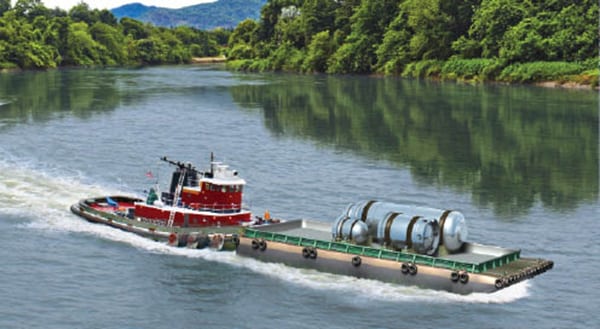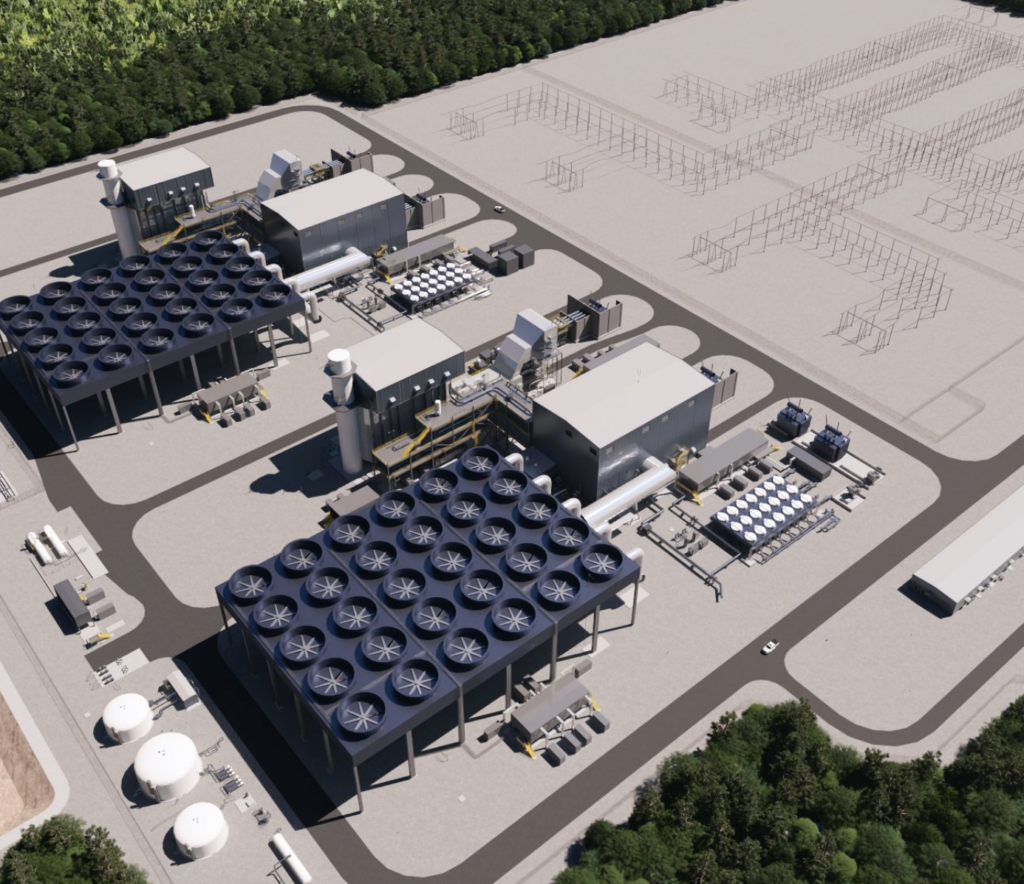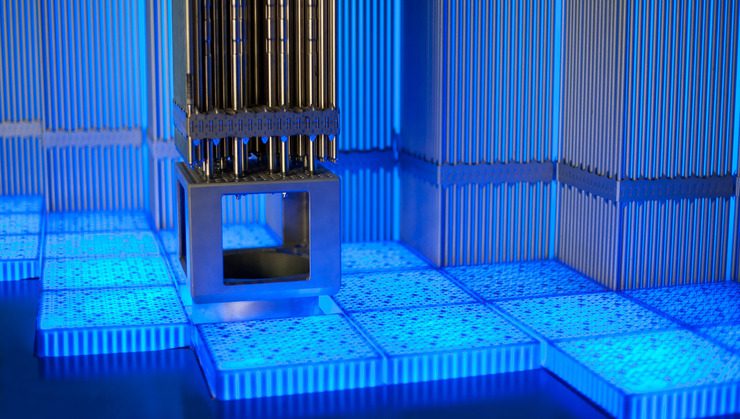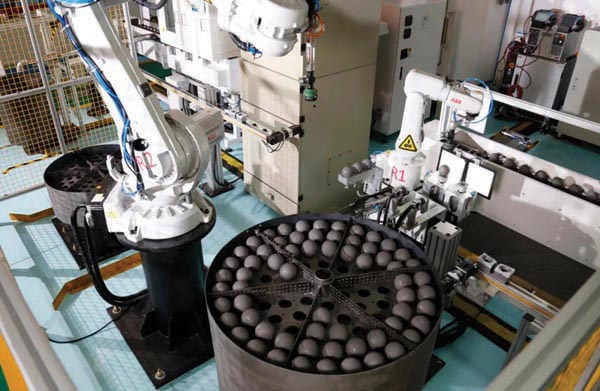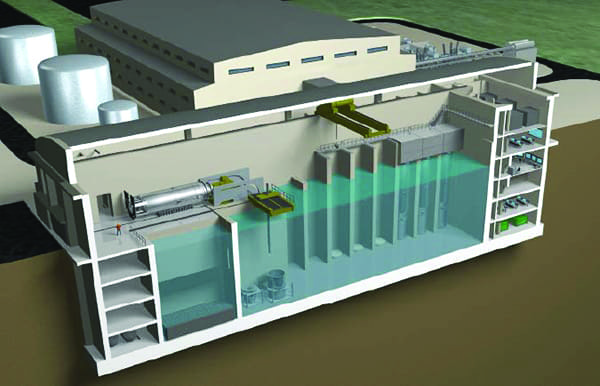The western U.S. could host the first NuScale small modular reactor, which traces its roots to Oregon State University. Financial backing from Fluor Corp. could make the design more than an academic exercise and provide a scalable, carbon-free electric power source by the mid-2020s.
The global nuclear industry has endured a rough patch since March 2011, when an earthquake and tsunami crippled the Fukushima Daiichi nuclear station in Japan. Attention in the U.S. after the accident focused on the ability of nuclear reactors to safely shut down in the event of a loss of power to water circulating pumps critical in keeping the reactor core cool. The Nuclear Regulatory Commission (NRC) adopted a number of recommendations for operators to follow, including enhancing the capability of operators to maintain plant safety during a prolonged loss of electrical power.
Then in January 2012, excessive wear in the tubes of replacement steam generators at a unit of the San Onofre Nuclear Generating Station (SONGS) in California focused a spotlight on materials that could lead to accelerated tube corrosion.
This past July, French nuclear operator EDF said it would exit the U.S. nuclear market, and Entergy said it would consider “all options” regarding its non-utility nuclear generating assets. Both companies cited low U.S. wholesale electric prices—the result of recent historically low natural gas prices—as among the reasons for their decision.
These concerns and market challenges aren’t lost on proponents of small modular reactors (SMRs), the genre of nuclear power plant that aims to combine modular, factory-built reactors with secure, reliable, and safe operations. POWER has already profiled the Babcock & Wilcox mPower and GE PRISM SMRs and has written about the Holtec and Westinghouse SMRs. Here we look at the NuScale SMR design, backed financially since 2011 by Fluor Corp.
Considering safety, Dr. Jose N. Reyes, chief technology officer for NuScale, told POWER in an interview that his company’s SMR relies on the laws of physics rather than mechanical equipment to provide an “infinite period of cooling” to the reactor core in the event of a Fukushima-type loss of power.
“It became apparent after Fukushima that our design had fundamental differences” with large-scale nuclear reactors, particularly in its ability to safely shut down and cool itself without electric power, Reyes said. In particular, the design relies on gravity and natural circulation to safely and passively cool the reactor. What’s more, at 45 MW, each module contains a relatively small amount of nuclear fuel. Reyes said this reduces considerably the environmental risk any one module would present in the event of a crippling accident.
Considering corrosion, NuScale has two large-scale test facilities in Italy that are conducting flow-induced vibration tests on full-length steam generator tube bundles. The aim is to learn if vulnerabilities exist similar to those found at SONGS. Test results are expected at the end of the year, Reyes said.
Considering economics, the company estimates that it can install a 12-pack of its 45-MW NuScale Power Modules (540 MW total plant output) for less than $5,000/kW. By comparison, the Energy Information Administration estimated earlier this year that advanced baseload nuclear generating capacity would carry an overnight cost of $4,700/kW (in 2011 dollars), a new scrubbed coal facility would be $2,694/kW, and a gas-fired combined cycle plant would run $931/kW. Adding carbon sequestration to the coal plant would lift its overnight cost to more than $4,600/kW. The overnight cost for a combined cycle plant would exceed $1,800/kW with carbon sequestration.
Even so, the economics of SMR might work for an entity that wants a scalable, zero-emissions source of electricity, and where transmission constraints make it difficult to site a much larger central generating station.
That makes the western U.S. an attractive location for one of the first SMRs. This past June, NuScale Power announced the launch of the Western Initiative for Nuclear (WIN)—a multi-western state collaboration—to study the demonstration and deployment of a multi-module NuScale SMR. A NuScale SMR built as part of WIN is projected to be operational by 2024.
If built, WIN would serve as the initial commercialization project for a potential series of projects that may be developed in other states. The first NuScale plant will most likely be developed, built and owned by a consortium of regional utilities, and operated by one of those utilities. The preferred location at this point lies within the Idaho National Laboratory site. The laboratory has a history of supporting nuclear power deployment, and the state’s governor has expressed support for an SMR deployment.
Oregon Roots
The NuScale SMR traces its origins to 2000, when the Department of Energy (DOE) funded research for the development of a small nuclear power plant for use in multiple applications. Idaho National Environment & Engineering Laboratory led the project with support from Oregon State University (OSU). At the same time, OSU was gaining notice for developing passive safety systems using natural circulation to cool nuclear plants. OSU built and operated 1,000-MW and 600-MW nuclear steam supply system scale models to help win NRC design certification for those technologies.
When the DOE research project ended in 2003, OSU scientists continued to pursue design of a small-scale nuclear plant that used natural circulation. Ultimately, the team built a one-third-scale electrically heated version of a plant. OSU granted NuScale Power LLC exclusive rights to the design, plus continued use of a test facility, through a 2007 technology transfer agreement.
In February 2008, NuScale began the process of seeking NRC design certification for its technology. The company currently is in the pre-application review phase.
In 2011, Fluor Corp. became NuScale’s primary investor with the intent of leveraging its engineering, fabrication, procurement, and construction capabilities, along with its global supply chain, to support commercialization. This past August, Rolls-Royce said it would back NuScale’s bid to commercialize its SMR technology globally and will help NuScale’s submission to DOE’s Funding Opportunity Announcement, a federal initiative aimed at bringing bring a scalable, SMR reactor to market by 2025.
NuScale describes itself as the only U.S.-based company established solely for the commercialization of its SMR. Using light water reactor (LWR) technology, the NuScale power module is cooled by natural circulation, is entirely self-contained, and is installed underwater and underground (Figure 1), which the developers say maximizes safety. The NuScale design claims to enable the reactor to safely shut down and self-cool indefinitely, with no operator action, no AC or DC power, and no additional water.
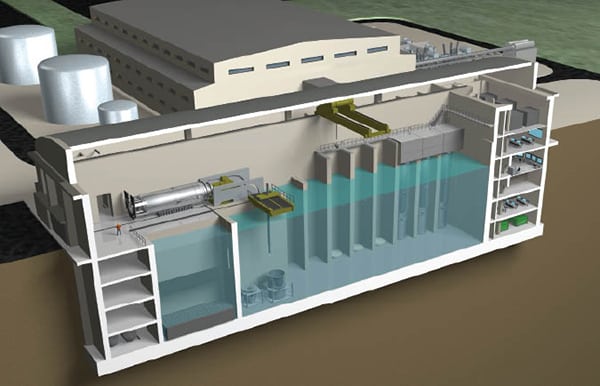 |
| 1. Reactor building. The fuel pool and control room are housed below ground level, enhancing safety. Courtesy: NuScale |
NuScale has pursued what it characterizes as an aggressive pre-application program with the NRC, consisting of nearly 40 technical meetings and submittals covering a range of technical and regulatory topics such as safety analysis, nuclear fuel, test programs, seismic analysis, and control room staffing.
Every February the NRC requires from SMR designers a regulatory information summary that is used for resource planning purposes at the federal agency. “In our case, we’ve provided thorough input” to help the NRC plan for its review of the NuScale design, said Michael S. McGough, chief commercial officer. He said the company is “pleased” with the level of resources the NRC has allocated to its SMR review process.
The objectives of the pre-application process are to inform the NRC of the unique NuScale Power Module and power plant design features and approach, resulting in review criteria applicable to NuScale in the form of an NRC-issued NuScale DSRS. Pre-application engagement will continue through design certification application (DCA) submittal, currently forecast for 2015.
While the DCA review process is under way, NuScale expects an applicant to file a combined construction and operating license application (COLA), allowing the design and COLA review processes to move ahead on parallel paths. The design ultimately certified by the NRC will be incorporated in the COLA. This supports a likely commercial date in the early 2020s.
Design Specifications
Each NuScale power module is intended to be a self-contained module that operates independently of the other modules in a multi-module configuration (Figure 2). However, all modules are managed from a single control room. The reactor itself would measure 65 feet tall x 9 feet in diameter. It would sit within a containment vessel, and the reactor and containment vessel would operate inside a water-filled pool built below grade.
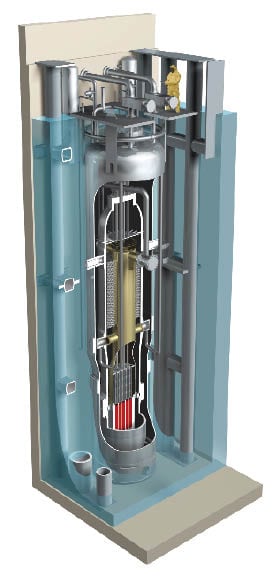 |
| 2. Reactor module. The light water reactor NuScale Power Module is cooled by natural circulation and is entirely self-contained. Courtesy: NuScale |
The reactor is designed to operate using the principles of natural circulation; hence, no pumps are needed to circulate water through the reactor. Instead, the system uses natural forces of physics—convection, conduction, and gravity. To begin the process, primary coolant water is heated as it passes over the core. As it heats up, buoyancy forces cause the water to rise through a riser tube within the interior of the vessel. The riser tube is surrounded by steam generator tubes, which contain cooler water called secondary coolant. The cooler water in the steam generator tubes cools the primary coolant and the secondary coolant is heated in the process of this heat exchange by conduction through the tube walls. As the primary coolant cools, it becomes more dense, which causes it to be drawn by gravity back to the bottom of the reactor vessel, where the natural circulation process begins all over again. Water in the reactor system (primary coolant) is physically separate from water in the steam generator system (secondary coolant), which prevents cross-contamination.
The secondary coolant inside the steam generator tubes is heated to steam and exits the reactor vessel. The steam spins turbines, which are attached by a single shaft to the electrical generator. After passing through the turbines, the steam loses its energy. It is cooled back into liquid form in the condenser and then pumped by the feedwater pump back to the steam generator, where it begins the cycle again.
Key NuScale power module specifications include:
■ Thermal capacity: 160 MWt
■ Electrical capacity: >45 MWe in modules that can be scaled to reach 540 MWe in size
■ Capacity factor: >95%
■ Dimensions: 82’ x 15’ cylindrical containment vessel module containing reactor and steam generator
■ Weight: 650 tons as shipped from fabrication shop
■ Transportation: Barge, truck, or train (Figure 3)
■ Cost: <$5,000/kW achieved through numerous advantages due to simplicity, off-the-shelf standard items, modular design, and shorter construction times
■ Fuel: Standard light water reactor fuel in 17 x 17 configuration, each assembly 2 meters in length; 24-month refueling cycle with fuel enriched less than 4.95%.
Multiple Layers of Safety
NuScale’s design incorporates multiple layers of defense to prevent the release of contamination into the environment, including: oxide fuel pellet and cladding, reactor vessel, containment vessel, reactor pool, underground stainless steel–lined concrete pool walls and floor, biological shield, and an HVAC filtered Seismic Category 1 reactor building.
The reactor building houses the systems and components required for plant operation and shutdown. The reactor building is a Seismic Category 1 reinforced concrete structure designed to withstand the effects of aircraft impact, environmental conditions, natural phenomena, postulated design basis accidents, and design basis threats. The reactor building also provides radiation protection for plant operation and maintenance personnel.
Portions of the reactor building are located above and below grade. The power modules, reactor pool, and the spent fuel pool are located at or below nominal plant grade level, while the hoisting and handling equipment is above grade. Also below grade are the Class 1E batteries for post-accident monitoring, main control room, most primary systems, and some radioactive waste equipment.
The surface of the reactor pool water is at ground level. At a 12-module facility, the NuScale power modules are installed in a vertical position and arranged into two rows of six modules along the reactor pool walls. Concrete walls separate the modules in individual reactor bays. An extra reactor bay is located adjacent to the units either for module maintenance or storage of a possible spare module. A central channel is provided between the rows of modules to allow for moving of the modules between the reactor pool and the connected refueling pool.
Pipes interfacing with the NuScale power module (for example, feedwater piping, steam piping, the chemical and volume control system, containment evacuation system, instrumentation, and power connections) are located above the water level. Pipe fittings are provided in this area to permit manual connection and disconnection during module installation, refueling outages, and during replacement or removal of modules.
To the maximum extent practical, equipment rooms or vaults within the reactor building are partitioned to provide separation between primary and supporting systems for each power module.
Reactor Pool. The reactor pool consists of a below-grade concrete pool with a stainless steel liner that provides stable cooling for the power modules for an unlimited period of time following any actuation of the emergency core cooling system (ECCS). During normal plant operations, heat is removed from the pool through a closed-loop cooling system and ultimately rejected into the atmosphere through a cooling tower or other external heat sink.
In an accident where AC power is lost, core decay heat is transferred to the reactor pool by passive safety systems. Over time, the pool will gradually heat up and begin to boil. The amount of water stored in the reactor pool is large enough to remove core decay heat from all the power modules for an unlimited period of time without adding water. After an extended period, the pool supply will have been reduced and the remaining heat in each module will be less than 400 kW, which transitions to air-cooling by the natural circulatory flow in the operating bays. In a design-basis accident scenario, the reactor core never becomes uncovered with water, NuScale said.
Containment Vessel. The major safety functions of the containment vessel are to contain the release of radioactivity following postulated accidents, protect the reactor pressure vessel and its contents from external hazards, and provide an interfacing medium (reactor vessel to water, to containment vessel, to the pool) for decay heat removal following an accident or normal reactor shutdown.
The containment vessel is submerged in the reactor pool, which provides a passive heat sink for the containment heat removal. The reactor pool provides an additional means of fission product retention beyond that of the fuel, fuel cladding, reactor pressure vessel, and the containment for certain events. The containment vessel is designed to withstand the environment of the reactor pool as well as the high pressure and temperature of any design basis accident.
Containment vessel pressure is maintained at a vacuum under normal operating conditions, providing for reduced moisture that could contribute to component corrosion and impact the reliability of instrumentation and other systems within the containment vessel. The vacuum essentially eliminates convection heat transfer, removing the need for “direct-contact” reactor pressure vessel insulation. The vacuum also enhances steam condensation rates that would occur during an accident with ECCS actuation and limits the available oxygen, which is beneficial for severe accident combustible gas control.
Following an actuation of the ECCS, heat removal through the containment vessel reduces the containment pressure and temperature and maintains them at less than design conditions for extended periods of time. Steam is condensed on the inside surface of the containment vessel, which is passively cooled by conduction and convection of heat to the reactor pool water.
Decay Heat Removal System. The decay heat removal system (DHRS) provides secondary side reactor cooling for non-ECCS events when normal feedwater is not available. The system is a closed-loop, two-phase natural circulation cooling system. Redundant trains of decay heat removal equipment are provided, one attached to each steam generator loop. Each train is capable of removing 100% of the decay heat load to cool the reactor coolant system. Each train has a passive condenser submerged in the reactor pool. The condensers are maintained with sufficient water inventory for stable operation.
Emergency Core Cooling System. The ECCS consists of two independent reactor vent valves and two independent reactor recirculation valves. The ECCS provides a means of decay heat removal in the event of a loss of coolant accident or a loss of the main feedwater flow in conjunction with the loss of both trains of the DHRS.
Following a small-break loss of cooling accident or other condition resulting in an actuation of the ECCS, heat removal through the containment vessel rapidly reduces the containment pressure and temperature and maintains them at acceptably low levels for extended periods of time. Steam is condensed on the inside surface of the containment vessel, which is passively cooled by conduction and convection of heat to the reactor pool water. Since the containment vessel is evacuated to a low absolute pressure during normal operation, only a small amount of noncondensable gas will be present inside the containment vessel.
Chemical and Volume Control System. The primary functions of the chemical and volume control system (CVCS) are to purify reactor coolant, adjust the boron concentration in the reactor coolant, and supply spray flow to the pressurizer. Equipment within the CVCS also allows for chemical addition to the reactor coolant and heats the reactor coolant during startup. The CVCS contains safety-related valves credited with stopping inadvertent boron dilution and inadvertent addition of reactor coolant inventory.
Will the Market Respond?
Whether or not a commercial market exists for SMRs remains to be seen. But in the quest for zero-carbon baseload power generation capacity that is also scalable and capable of being sited close to the load center, designs like NuScale’s may well be a game changer. ■
— David Wagman is content director for the ELECTRIC POWER conference, which will be held April 1–3, 2014, at the Ernest N. Morial Convention Center in New Orleans.


